Bull market Phase III
By Colin Twiggs
December 10, 2016 midnight ET (4:00 p.m. AEDT)
Disclaimer
I am not a licensed investment adviser.
Everything contained in this web site, related newsletters, training videos and training courses (collectively referred to as the "Material") has been written for the purpose of teaching analysis, trading and investment techniques. The Material neither purports to be, nor is it intended to be, advice to trade or to invest in any financial instrument, or class of financial instruments, or to use any particular methods of trading or investing.
Advice in the Material is provided for the general information of readers, viewers and course attendees (collectively referred to as "Readers") and does not have regard to any particular person's investment objectives, financial situation or needs. Accordingly, no Reader should act on the basis of any information in the Material without properly considering its applicability to their financial circumstances. If not properly qualified to do this for themselves, Readers should seek professional advice.
Investing and trading involves risk of loss. Past results are not necessarily indicative of future results.
The decision to invest or trade is for the Reader alone. I expressly disclaim all and any liability to any person, with respect of anything, and of the consequences of anything, done or omitted to be done by any such person in reliance upon the whole or any part of the Material.
United States
Bellwether Transport stock, Fedex signals a rise in economic activity with its breakout above 180, reaching a new high. Rising Money Flow indicates strong buying pressure.
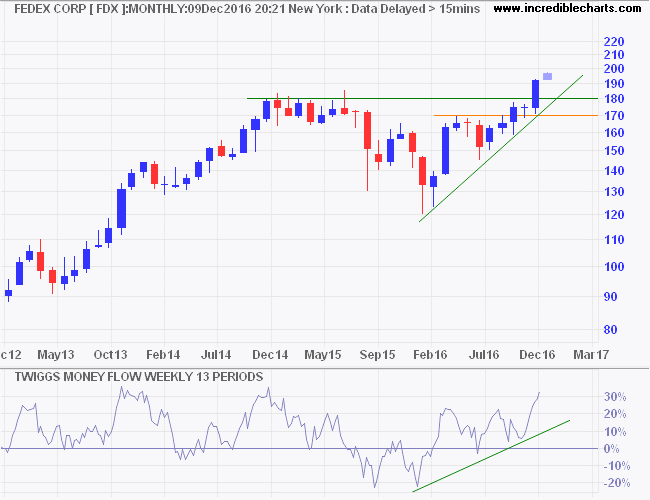
The tech-heavy Nasdaq 100 is testing its all-time high at 4900, first reached in the Dotcom bubble of 1999/2000. Follow-through above 5000 would suggest that we are in Phase III of a bull market.
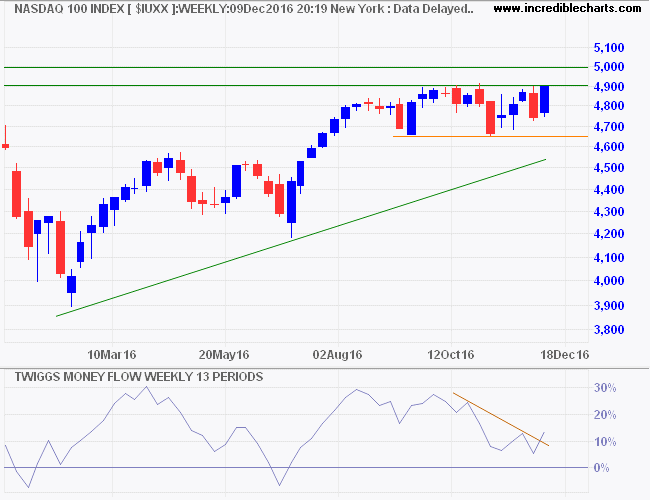
Bull market phases are described by Robert Rhea in The Dow Theory (emphasis added):
There are three phases of a bull period: the first is represented by reviving confidence in the future of business; the second is the response of stock prices to known improvement in corporation earnings, and the third is the period when speculation is rampant and inflation apparent—a period when stocks are advanced on hopes and expectations.
Market capitalization of Dow Jones Wilshire 5000 broad market index is at a record high against GDP [the blue line], indicating stocks are overpriced.
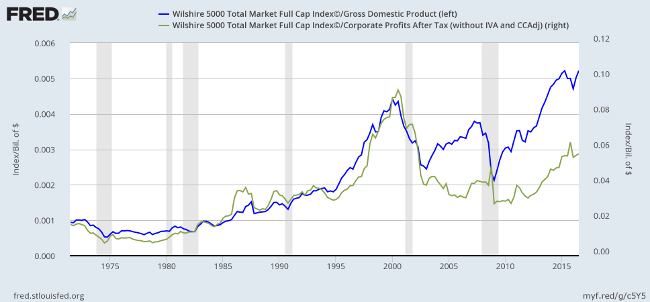
The ratio of market capitalization against corporate profits (after tax) is higher than at any time over the last four decades other than the extremes of the Dotcom bubble. Corporate profits are high in relation to GDP but these are likely to fall as employee costs rise.
The graph below shows profit margins [blue] are falling as employee compensation [brown] rises.
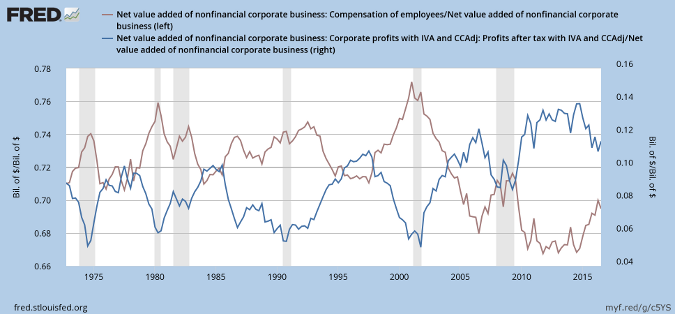
This was highlighted in my October 8 summary:
Corporate profits grew at a faster pace than GDP because wage growth was stagnant. The [graph] shows Employee Compensation fell as a percentage of Net Value Added from a Dotcom high of 77% to a post-GFC low of 67%, while corporate earnings soared from below 6% to a high of 14%.
Since 2015, however, employee compensation has started to recover as the labor market tightens. And corporate earnings are falling (as a % of Net Value Added).
If you look back to the 1960s, the pattern is the same. Profits rise after a recession as labor costs fall. When the labor market reaches capacity, profits fall as labor costs rise. Then the Fed intervenes to tame inflation from rising labor costs, causing another recession.
The S&P 500 (weekly chart) is unconcerned, having respected the new support level at 2200, while 13-week Twiggs Money Flow is recovering, indicating medium-term buying pressure. Target for the advance is 2300*.
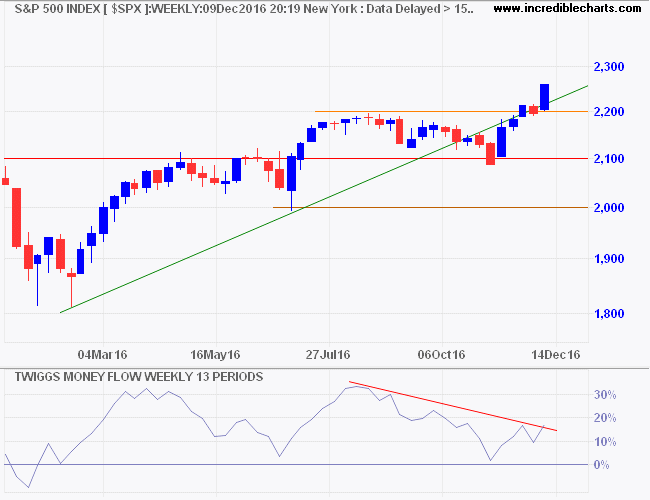
* Target medium-term: 2100 + ( 2200 - 2000 ) = 2300
Phase III of a bull market can last for several years so it may be unwise to withdraw from the market. But we need to constantly remind ourselves that prices may not be supported by earnings and reactions are likely to be sharper and steeper than in earlier market phases.
Probably the greatest harm done by vast wealth is the harm that we of moderate means do ourselves when we let the vices of envy and hatred enter deep into our own natures. But there is another harm; and it is evident that we should try to do away with that. The great corporations which we have grown to speak of rather loosely as trusts are the creatures of the State, and the State not only has the right to control them, but it is duty bound to control them wherever the need of such control is shown.
~ President Theodore Roosevelt (1902)

Author: Colin Twiggs is a former investment banker with almost 40 years of experience in financial markets. He co-founded Incredible Charts and writes the popular Trading Diary and Patient Investor newsletters.
Using a top-down approach, Colin identifies key macro trends in the global economy before evaluating selected opportunities using a combination of fundamental and technical analysis.
Focusing on interest rates and financial market liquidity as primary drivers of the economic cycle, he warned of the 2008/2009 and 2020 bear markets well ahead of actual events.
He founded PVT Capital (AFSL No. 546090) in May 2023, which offers investment strategy and advice to wholesale clients.
